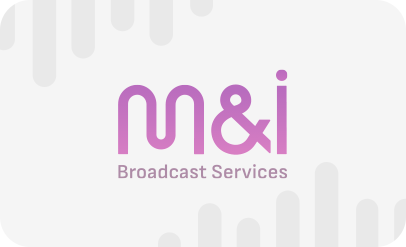
- Home
- >
- M&I's Blog
- >
- Company news
- >
- 5 Reasons Why Radios Need to Automate Radio Production
Company news
5 Reasons Why Radios Need to Automate Radio Production
5 Reasons Why Radios Need to Automate Radio Production

Radio stations are increasingly seeking ways to streamline their operations due to today’s challenges. These challenges include the need to adapt to new listening habits and manage content distribution across diverse platforms.
Automation is a critical advancement that makes modern radio broadcasting processes more efficient. It equips broadcasters to handle this increasing complexity while continuing to offer their listeners the same high-quality programming.
In this article, we’ll get into the specifics of how the cutting edge technology known as radio automation can help – so, read on to find out our top five reasons to implement it today.
Related categories:
1. Control Your Catalog
A meticulously organized catalog is the backbone of any successful radio station, and automation brings a new level of control over your entire content repository. But it’s not just about keeping the items in order – it’s about harnessing the catalog’s full potential.
With automation, you can efficiently categorize, search, and retrieve any piece of content within seconds, ensuring that the right content is always at producers’ fingertips.
Hours upon hours are wasted every year due to inefficient file management – not to mention the financial losses that follow. Businesses are said to waste $20,000 per year due to poor file/document management, which stems from a lack of systematisation and underestimations of the time taken to process files, among other forms of chaos.
(Interestingly, some research shows that Millennials are the most likely to struggle to find files compared to Gen X and Boomers.)
Finally, according to the Association for Intelligent Information Management, electronic records are twice as likely to be described as unmanaged compared to paper records. While this figure does not specifically apply to media asset management, it illustrates that many businesses still have some catching up to do in terms of digitisation.
2. Easy Scheduling and Playout
Gone are the days of manual scheduling and playout processes, which are not only time-consuming but also prone to human error.
Automation introduces a streamlined approach to radio scheduling, where content and adverts are effortlessly organized into playlists with precision – months in advance, if necessary.
Systematising the process in this way ensures that programming is consistent, coherent, and in line with the station's broadcasting strategy.
In addition, automated playout guarantees that playlists go on air exactly as planned, providing listeners with a seamless and enjoyable listening experience, free from unexpected disruptions.
3. On Air Management
The dream of fully automating on air management is now a reality. As you know, on air management encompasses everything from the instant playback of scheduled content to the automatic mixing of tracks and real-time adjustments to the broadcast based on listener feedback and other factors.
This level of automation not only vastly reduces the workload for staff but also significantly improves the quality and consistency of the broadcast, ensuring that the station sounds professional and engaging at all times.
4. Distribution for Your Content
Automation opens up new avenues for content distribution, making it effortless to share programs across various digital platforms. This expanded distribution broadens the reach of the station's content to a global audience, tapping into new listener bases and creating opportunities for increased engagement, sponsorship, and revenue streams.
In fact, in the US, internet radio platforms account for more than USD 585 million in revenue from music streaming. Other research shows that the European internet radio market is growing, while the global market is forecast to be worth USD 8.56 billion in 2030 (up from USD 2.26 billion in 2022).
Whether it's pushing content to streaming services, social media, or the station's own website, automation ensures that the station's voice is heard far and wide. To manage distribution across all platforms manually is a time-consuming task, while using automated tools makes it possible to do so with ease.
5. Integration and Flexibility
Modern automation systems are designed to work seamlessly with third-party systems such as Spotify. This integration capability means stations can easily adapt their programming to include music tracks, podcasts, or any other content available through external platforms, ensuring that their broadcasts remain fresh, relevant, and in tune with listeners' changing preferences.
Omniplayer Radio Automation Software: How it Streamlines Broadcasting Processes
If you’re looking for the best radio automation software, look no further – OmniPlayer is our advanced solution offering a suite of intuitive tools for creating, broadcasting, and publishing content. As a result, radio stations can operate more efficiently and profitably. Let’s look at how it brings about the benefits discussed above.
Comprehensive Catalog Control Tools
At the core of OmniPlayer’s capabilities is the profound control it gives radio broadcasters over their catalog. Here are the highlights:
- Database Explorer for full catalog control. It allows simultaneous access and updates by users from multiple workstations.
- Custom field editor for metadata customization. Users can creation new fields and forms or use the default fields.
- Multi Basebrowser for sharing resources between sites. In a few clicks, users can transfer titles and soundfiles across databases.
How Does OmniPlayer Automate Scheduling and Radio Playout?
Scheduling and playout have never been simpler, thanks to the following features:
- Log Editor for easy scheduling, enabling advance playlist creation and editing for various channels and time frames.
- Template Creation for efficient schedule management, allowing users to create, save, and reuse scheduled block models.
How Does Radio Automation Software Simplify On Air Management?
OmniPlayer transforms on-air management and enables fully automated broadcasting. Here’s how:
- Radio playout client for integrated music, commercial, and off-air editing. It features various real-time clocks and countdowns, with a user-friendly interface for a stress-free experience.
- Live assist for seamless and versatile broadcasting, supporting drag-and-drop playlist modifications.
- Singleplayer for full broadcast automation, enabling easy playlist creation and integration with additional broadcasting platforms (i.e., web, satellite or DAB+).
- Sequence Preparation for quick audio title sequencing, offering customizable settings for smooth transitions between tracks.
Content Distribution
With the features below, OmniPlayer makes web based radio automation across various platforms an effortless task. Broadcasters can then reach their audience no matter where they want to listen.
Multichannel Digital Publishing
We offer seamless API integration for content distribution across Facebook, Twitter, MixCloud, and podcast channels, with options for immediate or scheduled posting.
Workflow Optimization
Our intelligent Social Media Workflow Engine streamlines publishing processes, including crossfade management and content insertion on social platforms.
Visual Radio Capabilities
Enhance audience engagement with live video, music clips, and news segments broadcasted simultaneously on radio and TV, controlled using OmniPlayer's intuitive interface.
The Ultimate in Flexibility
Our radio automation software offers unparalleled flexibility, meeting the unique needs of each broadcaster. The features below make this possible.
Seamless Third-party System Integration
We ensure compatibility with a wide range of non-linear editors, camera switching systems, and mixing consoles via protocols like Ember+, DHD Global Logics, and Livewire+.
Extensive API Integration
Our web service API enables customization and deeper integration with in-house systems, supporting large-scale projects through both customer and third-party development.
Customizable Metadata
Broadcasters can tailor metadata schemes, enhancing media sharing and distribution across departments or sites with IP-based transfers and multi-codec support.
Music Playlist Importation
Access endless titles through systems such as Spotify, PowerGold and Music Master thanks to our API. It facilitates the import of music playlists for enhanced scheduling and playlist management within the LogEditor and On-Air applications.
Automating radio production is not just a matter of keeping up with changing technological standards. It’s about taking a proactive step towards staying competitive and engaging in light of evolving listening habits.
OmniPlayer’s comprehensive features automate many crucial aspects of radio broadcasting, from catalog control and scheduling to on-air management and content distribution. It also has a range of advanced production tools. To learn more or request a demo, contact us today.
Articles you might be interested in

Aina Martínez Boixader
|10 September 2024 -
3 min read
GULFSAT propels MarinaFM with OmniPlayer Radio Play Out
M&I Broadcast Services is excited to announce that Gulfsat has chosen OmniPlayer as the new radio playout and production suite for their radiostation MarinaFM in Kuwait.

Aina Martínez Boixader
|-
2 min read
NIMBUS Newsroom unlocks the world with Exchange platform
M&I Broadcast Services is excited to announce that Nimbus Newsroom is being enforced by adding the Nimbus Exchange platform.

Irene Pesos
|28 May 2024 -
3 min read
M&I Broadcast Services Expands to North America with OmniPlayer
M&I Broadcast Services is excited to announce its expansion into North America. This strategic move marks a significant milestone in our company's growth and underscores our commitment to providing top-tier broadcast and media services all around the world.

